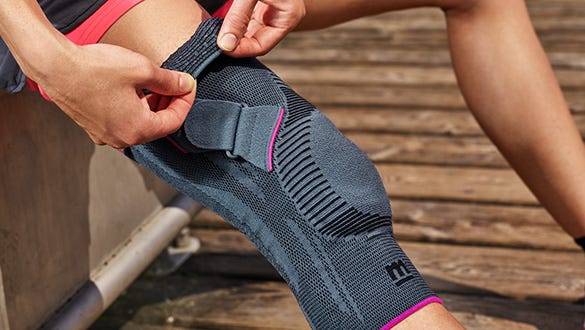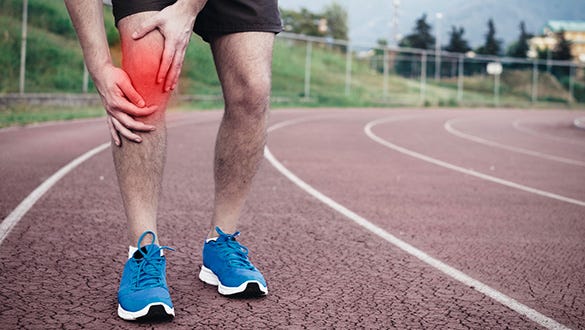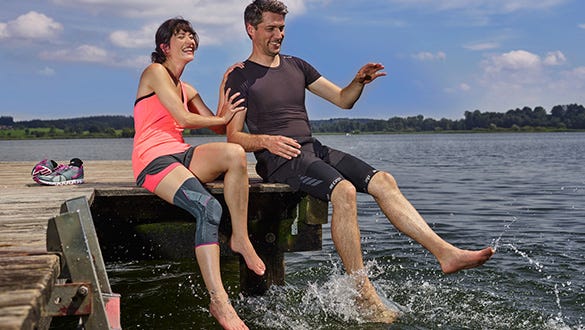- Free First Class Delivery
- Buyer Protection
- Secure Online Shopping
- Healthcare Professional? Click here
Patellofemoral pain syndrome
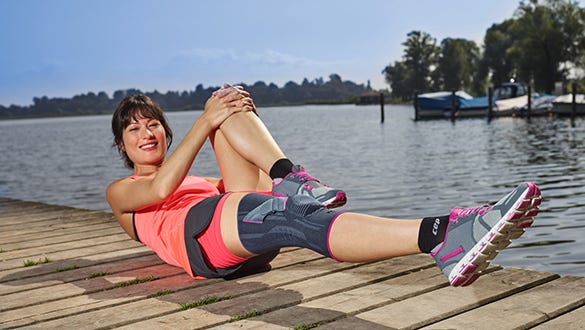

Categories
What is the patellofemoral pain syndrome (PFSS)?
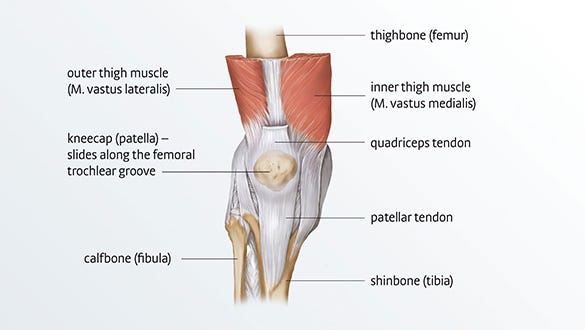

The term patellofemoral pain syndrome (PFSS) is also commonly known as runner’s knee. The term is broadly used to describe pain in behind or under the knee cap and around the patella. The pain and, often joint stiffness, mainly occurs when climbing stairs, kneeling, after long periods of sitting or when partaking in sporting activities. Many things contribute to the development of PFSS but they are mainly down to knee cap alignment problems or over use from vigorous training.
The following synonyms are used for the patellofemoral pain syndrome (PFSS):
- Femoropatellar pain syndrome (FPS)
- Retropatellar pain
- Patellar chondropathy
- Patellar chondromalacia
Causes
In a healthy person, the kneecap sits in the femoral groove (the grove on top of the femur) and is held in place by ligaments on each side. The muscles actively support the patella in gliding along the centre of the groove. If the kneecap is unstable or not aligned properly, it doesn’t’ run smoothly in the femoral groove and, in can sometimes jump out its place. This is rare but very painful.
We distinguish between three degrees of instability:
- Lateralisation of the patella (the kneecap glides along the side of the patellar groove)
- Subluxation of the patella (the kneecap almost dislocates)
- Dislocation of the patella (the kneecap dislocates completely)
The cause of the pain is usually down to a combination of components that predispose the patella to dislocation. From an anatomical viewpoint, these can include anomalies of the patellar groove or the shape of the patella itself.
Other risk factors include a hypermobility of the kneecap, a high patella or an imbalance between the inner and the outer muscles over the front of the thigh. The latter condition can lead to a situation, in which the shortened muscles pull the kneecap to the side over the tendons, resulting in instability of the kneecap.
Trigger points
Healthy muscles contract and then relax again. Overstrain can lead to the outer thigh muscle first contracting permanently and then shortening. This can result in the formation of trigger points that cause local and radiating pain. Symptoms in the knee can also be associated with the formation of a trigger point in the outer muscles over the front of the thigh.
Signs and symptoms
The pain is felt behind, next to or under the kneecap. Often, the symptoms onset after long periods of sitting or resting the knee joint, this is referred to as start-up pain. Symptoms are also often connected with sporting activities or when climbing stairs.
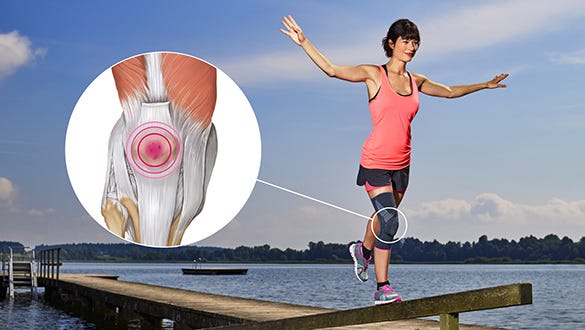

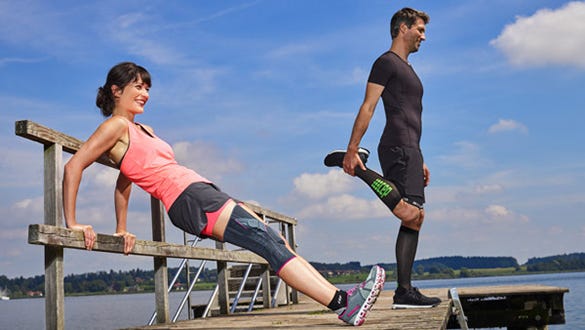

Risk factors of PFSS
The following risk factors predispose to the patellofemoral pain syndrome:
- Abnormal shape of the patellar groove or of the patella itself – this prevents the kneecap gliding smoothly in its correct place
- Hypermobility of the kneecap (kax ligamentous apparatus)
- High sitting patella
- Imbalance between the inner and the outer muscles over the front of the thigh – the shortened muscles pull the kneecap to the side over the tendons. The result: instability of the kneecap.
Prevention
With the right exercises, you can stay fit and mobile and help to prevent the pain. It is important to consider strengthening the muscles over the front of your thigh with regular exercises that can be done at home if necessary. Doing these will have a positive influence on the direction of pull on the kneecap.
Therapy of patellofemoral pain syndrome
Most cases of lateralisation or subluxation of the kneecap are treated conservatively, i.e. without an operation. The patient is recommended to wear a knee support (for lateralisation) or a knee orthosis (for dislocation) to stabilise the kneecap and the knee joint. If the kneecap dislocates once or even several times, an operation may be considered. It is also important to correct the direction of pull on the kneecap. Physiotherapy exercises and regular training will help to strengthen the muscles over the front of the thigh.
Physiotherapy exercises
Strengthening
Knee bending exercises with a ball
Knee bending exercises with a ball – muscles involved: thigh
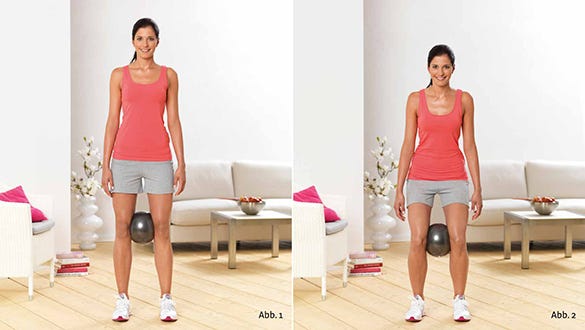

Starting position:
- Stand upright.
- Hold an exercise ball at knee height between your legs.
Exercise:
- Bend your knees and hips.
Dosing:
Perform 3 sets of the exercise with 10 to 15 repetitions per set. Take a 1 – 2 minute rest between the sets.
Note:
- Keep your back straight.
- Keep your heels on the ground at all times during the exercise.
Knee straightening
Knee straightening – muscles involved: quadriceps
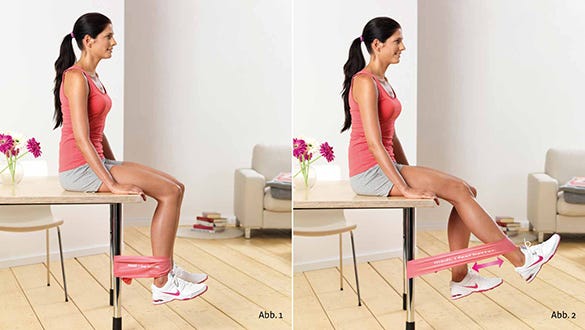

Starting position:
- Tie the exerciser around a table leg (loop approx. 30 cm long).
- Sit on the table and place the loop around your ankle.
- Your legs should be bent at an angle of 90°, but don't let your feet touch the floor.
- Point the tips of your toes upwards.
Exercise:
- Straighten your leg by about one shoe length and then return your foot to the starting position.
Dosing:
Perform 3 sets of the exercise with 10 to 15 repetitions per set. Take a 1 – 2 minute rest between the sets.
Single-leg knee bending exercises
Single-leg knee bending exercises - muscles involved: thigh
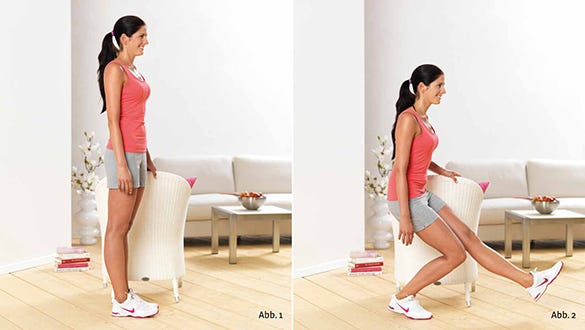

Starting position:
- Stand next to a chair you can hold on to securely.
- You will be exercising your standing leg in this exercise.
Exercise:
- Now straighten your standing leg.
- Slightly bend the knee of the other leg.
Dosing:
Perform 3 sets of the exercise with 10 to 15 repetitions per set. Take a 1 – 2 minute rest between the sets.
Note:
- Keep your back straight.
- You can bend your hips slightly.
Stabilisation
Leg abduction
Leg abduction – muscles involved: outside of the leg, abductors
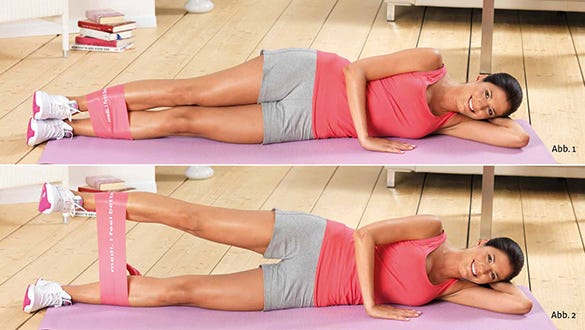

Starting position:
- Tie the exerciser into a loop approx. 30 cm long.
- Lie on your side (with the leg you are exercising uppermost).
- Slip the exerciser around both ankles.
Exercise:
- Lift the upper leg up slowly against the resistance of the exerciser.
- Now lower the upper leg – but make sure the exerciser remains under tension thereby.
Dosing:
Perform 3 sets of the exercise with 10 to 15 repetitions per set. Take a 1 – 2 minute rest between the sets.
Obstacle course
Obstacle course – muscles involved: thigh
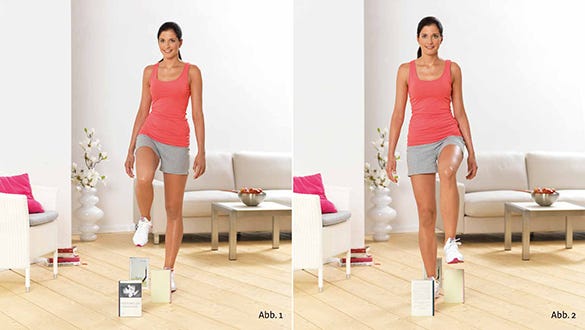

Starting position:
- Place ‘obstacles’ (approx. 20 cm high), for example books, alternately in front of your left and right legs.
- Stand up straight in front of the obstacle course.
Exercise:
- Lift up the first leg and walk over the first obstacle.
- Repeat this procedure with the second leg.
Dosing:
Perform 3 sets of the exercise with 10 to 15 repetitions per set. Take a 1 – 2 minute rest between the sets.
Note:
- Keep your upper body straight.
- Do not bend your hip sideways when walking.
Stretching
Quadriceps (standing)
Standing quadriceps stretch – muscles involved: front of the thigh
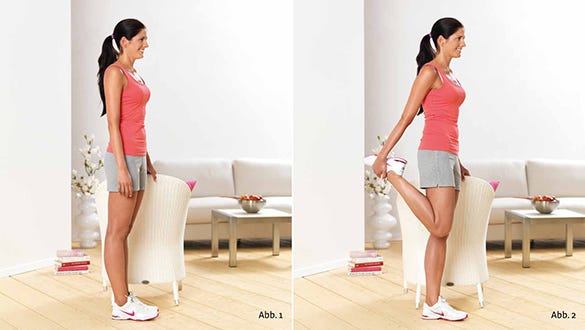

Starting position:
- Stand straight close to a chair or table you can hold onto.
- Make sure you stand up straight and avoid a hollow back.
Exercise:
- Bend the leg you are stretching and grasp your ankle.
- Pull your heel up towards your bottom until you feel the stretch.
Dosing:
Hold this position for 30 to 45 seconds, repeat the exercise three times. Relax and shake your legs briefly between each exercise.
Quadriceps (lying)
Lying quadriceps stretch – muscles involved: front of the thigh
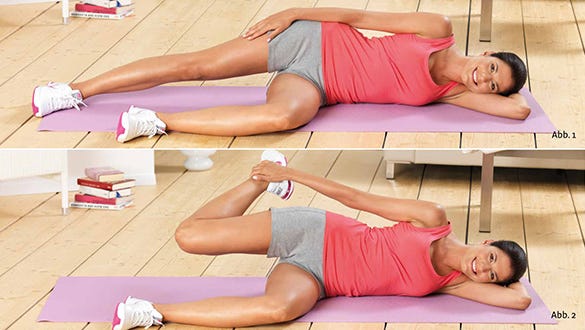

Starting position:
- Lie on your side with the leg you are stretching uppermost.
- Move the other (lower) leg forwards and bend it at the knee to an angle of 90°.
Exercise:
- Bend the upper leg backwards.
- Pull your heel up towards your bottom until you feel the stretch.
Dosing:
Hold this position for 30 to 45 seconds, repeat the exercise three times. Relax and shake your legs briefly between each exercise.
Note:
- Keep your upper body straight.
- Do not bend your hip sideways when walking.
Tract
Tract stretch – muscles involved: thick fibrous strip along the outside of the thigh
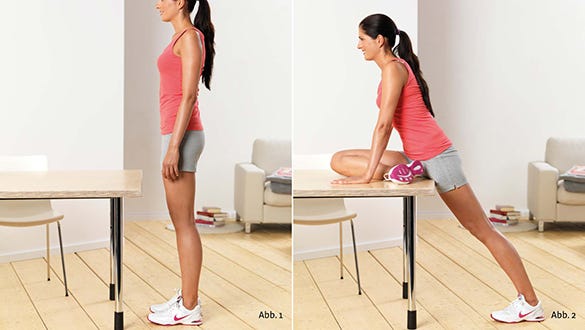

Starting position:
- Stand up straight about 20 cm in front of a table.
Exercise:
- Place the leg you are stretching (bent to about 90°) on the table.
- Now bend your upper body forwards until you feel a stretch.
Dosing:
Hold this position for 30 to 45 seconds, repeat the exercise three times. Relax and shake your legs briefly between each exercise.
Coordination
Step up
Standing quadriceps stretch – muscles involved: front of the thigh
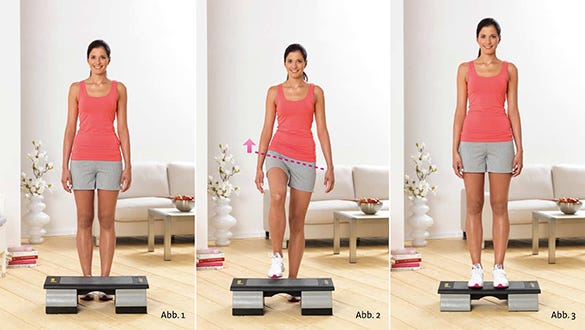

Starting position:
- Stand upright in front of an exercise stepper (alternatively stairs, wooden crate etc.).
- Keep your feet a shoulders' breadth apart.
Exercise:
- Keep your standing leg straight and lift your pelvis on the side of the swinging leg.
- Step up onto the exercise stepper (leaning forward slightly and with your leg bent), then lift your other leg up onto the exercise stepper as well.
Dosing:
Perform 3 sets of the exercise with 10 repetitions per set. Take a 1 – 2 minute rest between the sets.
Note:
- Keep your upper body straight.
Step down
Step down – muscles involved: thigh, gluteus, abductors
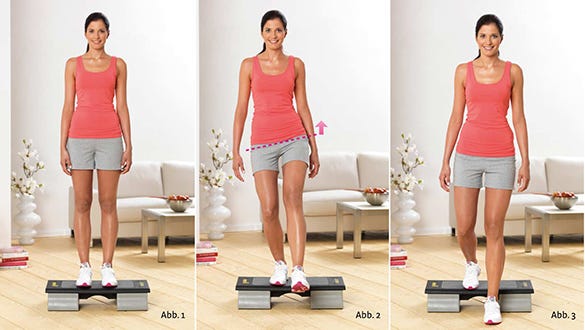

Starting position:
-
Stand with both legs on the exercise stepper (alternatively stairs, wooden crate etc.)
-
Keep your feet a shoulders' breadth apart.
Exercise:
-
Slightly bend your standing leg and lift your pelvis on the side of the swinging leg.
-
Now step down slowly from the exercise stepper with your swinging leg.
Dosing:
Perform 3 sets of the exercise with 10 repetitions per set. Take a 1 – 2 minute rest between the sets.
Note:
- Make sure that the knee of your standing leg does not turn in- or outward.
Lunge
Lunge – muscles involved: thigh
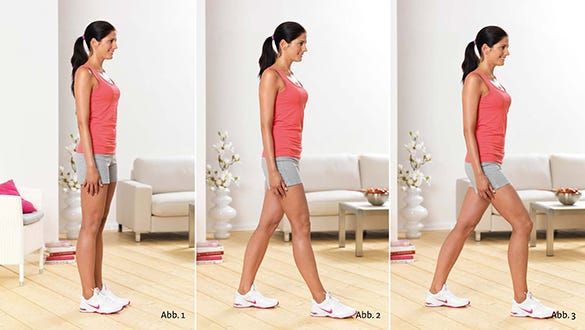

Starting position:
-
Stand up straight with your feet on the floor.
-
Stand with your feet a shoulders' breadth apart.
Exercise:
-
Take a step forward with your right foot.
-
Bend the leg you are exercising and slowly transfer your weight to your front foot.
Dosing:
Perform 3 sets of the exercise with 10 to 15 repetitions per set. Take a 1 – 2 minute rest between the sets.
Note:
- Make sure that the knee does not turn in- or outward.
Goose step
Goose step – muscles involved: thigh


Starting position:
-
Stand up straight with your feet on the floor.
-
Stand with your feet a shoulders' breadth apart.
-
The leg you will not be exercising is the leg you're standing on.
Exercise:
-
Bend your swinging leg and lift your hips / your pelvis as high as possible.
-
Stretch the bent leg out straight ahead of you.
-
Transfer your weight forwards onto your front standing leg.
Dosing:
Perform 3 sets of the exercise with 10 repetitions per set. Take a 1 – 2 minute rest between the sets.
Note:
- Make sure that the knee does not turn in- or outward.
Supports from medi
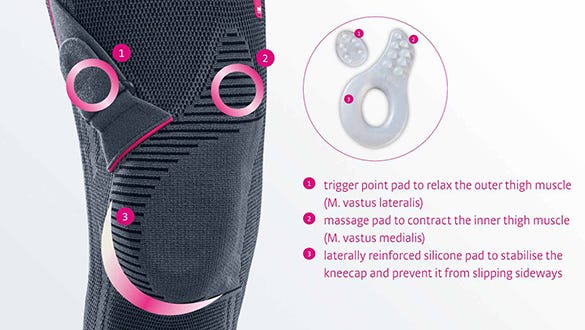

Genumedi PT – relief with the smile principle: Genumedi PT* effectively relieves anterior knee pain. With the smile principle, it acts directly on the cause of the pain – without any side effects whatsoever. An imbalance between the inner and the outer muscles over the front of the thigh is often seen as the cause of anterior knee pain.
While the outer muscle often becomes tense and shortens, the inner muscle tends to grow weak. The silicone cushions on the Genumedi PT have a specific action, through which the external thigh muscle becomes relaxed as a result of the response of the trigger point it targets. At the same time, the inner muscle is activated with the help of a pad.
The result: the missing balance between the muscles is restored. The laterally reinforced silicone ring also guides the kneecap to keep it in a central position within the femoral groove.
The ‘smile principle’ consists of three important components. If we trace over these components, a laughing face emerges, which perfectly illustrates the aim of the Genumedi PT*: you should soon be pain-free and smiling again.
More information
* Knee brace which guides patella tracking.

